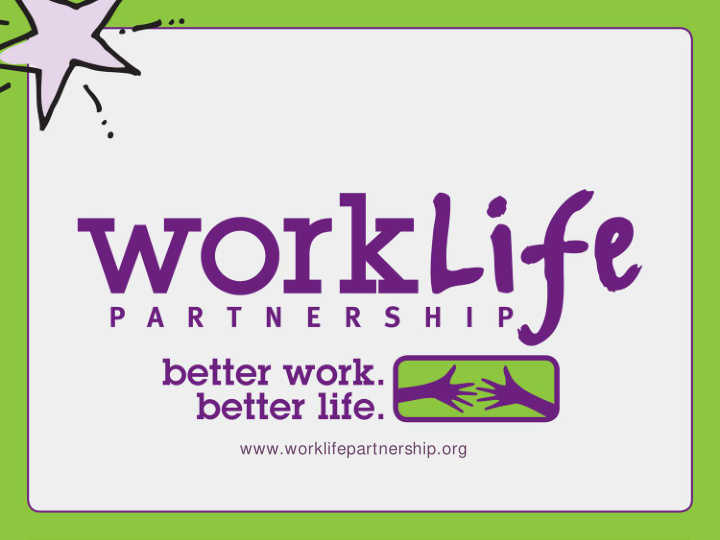



www.worklifepartnership.org
Introduction WorkLife History WorkLife Advocacy Getting the job is half the battle
Sustainable Communities and Thriving Workplaces: Focus on – stabilizing your workforce, our citizens, through retained and enhanced work – Stabilizing the family for generations to come; your customers! – Stabilizing the community by providing income-injection for business (the more people working, the more prosperous our businesses!) – Ensuring employers have a stable, promising workforce to choose from (economic development) – Thriving: reduce turnover to make a different to your bottom line, culture, and the way you do business
Why Retain front-line workers? The Business Economic Development Makers Model Skills Customer Sustainable Gap Service workforce Workplace Employer- Wellness driven
What is the Cost of Hiring? Calculating benchmark employee cost Average Departing employee annual base salary: Calculated annual benefits cost: Calculated monthly salary + benefits: Calculated daily salary + benefits: Cost of 'covering' a vacant position (Calculated costs of other employees 'filling in' while the position is vacant) Number of days until the vacant position is filled: Calculated daily cost of 'covering' a vacant position: Total cost to 'cover' vacant position: Cost to fill a vacant position HR/Hiring manager's annual salary: Calculated HR/Hiring manager's hourly rate: Number of ads placed Price of each ad Cost of advertising (online and/or print): Cost affiliated with resume screening: Number of Candidates interviewed for each position Number of interviewers Average Salary of interviewers Typical length of interview Cost of interviews Cost of behavioural and skills assessments: Cost of background checks (criminal, credit, reference, education): Job Placement Services or Recruiter Cost Cost of Recruiters (if applicable) Cost of travel/moving expenses (if applicable): Total cost to fill a vacant position: Onboarding & Orientation cost Trainer/Manager annual salary: Calculated trainer/manager daily rate: Total training days: Total onboarding and orientation cost: Cost of productivity ramp-up (During the first 3 months, an average new employee performs at 50% productivity of a tenured top performing employee) Daily employee cost (salary + benefits): Number of working days during first 3 months: Cost of productivity ramp-up:
What’s your Batting Average? How successful is your hiring?
Wages and Self Sufficiency
Understand where people are coming from In Mesa County, ‘self-sufficiency’ wage in 2011: Adult Adult+Presc Adult+presc 2 Adults + hooler hooler+scho preschooler ol age +school age Mesa Cnty $19,221 $34,394 $43,484 $49,389 $9.10/hr $16.28/hr $20.40 $11.80 per adult
Federal Poverty Guidelines Adult Adult + Adult + 2 Adults+ Mesa County Preschooler Preschooler Preschooler and School and School age age Self-sufficiency $19,221 $34,394 $43,484 $49,839 Standard (2008) Federal Poverty $10,400 $14,000 $17,600 $21,200 Guidelines (2008) Difference $8,821 $20,394 $25,884 $28,639
Workers earning between minimum and self- sufficiency wages Face challenges… That management practices and employee benefit strategies can help address But this is expensive and a hidden rule of management
Cliff Effect Workforce Barrier When a modest increase in earnings results in a significant reduction in work support benefits, the worker experiences a loss in overall economic well-being, increasing the struggle to make ends meet. Have you experienced people NOT taking their pay raise? Is public policy like this holding your people back from succeeding? Importance for business to make a difference
Self-Sufficiency Basic Needs met with some surplus. Better paying job, but not meeting basic needs. Emergency would send family back into the system or worse.
What we do: We help employees (and family members!) deal with life and work issues that keep them from getting to work, keeping their mind on work, and being a productive, valued employee. Training opportunities Financial health and wellness
Lack of resources at work Employee experiences barrier to work Unable to connect to resources Job performance declines Absence and turnover
Lack of resources at work Employee is retained, obtains financial stability, improve productivity Employee's situation improves Connects with needed resources (WorkLife or other benefits) Employee experiences barriers
Barriers to work 20 18 16 14 12 10 8 6 4 2 0
Potential Barriers:
Employee process:
OUR RESOURCES -Navigator -Training, like this one: ESL, Cultural Competency, Leadership/Management, Computer, Conflict Resolution -Loan Program -Financial Focus and Health -Creative problem solving…Transportation -Jobzology and Health Links -ACA Certified -Opportunity to network with 18 other employers -Help you launch programs toward a better workplace culture
Part of a Movement! Estimated in 2013: +596% ROI 90% Retention rate among those we serve 13 employers in Denver 5 in Northern Colorado Serving 12,000+ workers in Colorado ONLY ONE OF ITS KIND IN COLORADO
Coverage
Employer Members • Exempla Lutheran Medical Center AlliedBarton • St. Joseph Medical Center Aerotek • • Good Samaritan Medical Center KONG • • National Jewish Hospital Aqua Hot • • RTD WIN Columbine Health Systems • • CWEE- BridgeBuilder Gallegos Sanitation • • Boulder Circles JBS • • Wind Crest Total Facility Care • • Christian Living Communities University of Colorado Health • •
“Our employees are afforded resources and opportunities that we were unable to provide on our own. WorkLife removes those barriers to work that were causing us to lose top talent. Our clients recognize and appreciate this unique program that no other company in our industry has to support their employees." -Jewel Jenkins- Thurman, Regional Human Resources Director for AlliedBarton Security Service “Our culture is one in which we really do care about our employees, WorkLife helps provide the resources for those employees who need it. As an employer, we want to assist our employees when they go through difficulties but we don’t always have access to the best resources out there. WorkLife bridges that gap.” - Jennifer Barnes, HR Director, KONG "Your [WorkLife] business model is one of the best I have seen in bringing solutions closest to the problem."- Jan Roth, Executive Director of HR, Christian Living Communities
Next Steps • Rural Model Assistance Programs • Ways to assist workers for employers • What is your pain? with 1-2 employees • Could employees partake in training for • A ‘different’ version of Employee continued improvement online?
Recommend
More recommend